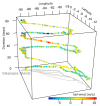The environmental-data automated track annotation (Env-DATA) system: linking animal tracks with environmental data
- PMID: 25709817
- PMCID: PMC4337772
- DOI: 10.1186/2051-3933-1-3
The environmental-data automated track annotation (Env-DATA) system: linking animal tracks with environmental data
Abstract
Background: The movement of animals is strongly influenced by external factors in their surrounding environment such as weather, habitat types, and human land use. With advances in positioning and sensor technologies, it is now possible to capture animal locations at high spatial and temporal granularities. Likewise, scientists have an increasing access to large volumes of environmental data. Environmental data are heterogeneous in source and format, and are usually obtained at different spatiotemporal scales than movement data. Indeed, there remain scientific and technical challenges in developing linkages between the growing collections of animal movement data and the large repositories of heterogeneous remote sensing observations, as well as in the developments of new statistical and computational methods for the analysis of movement in its environmental context. These challenges include retrieval, indexing, efficient storage, data integration, and analytical techniques.
Results: This paper contributes to movement ecology research by presenting a new publicly available system, Environmental-Data Automated Track Annotation (Env-DATA), that automates annotation of movement trajectories with ambient atmospheric observations and underlying landscape information. Env-DATA provides a free and easy-to-use platform that eliminates technical difficulties of the annotation processes and relieves end users of a ton of tedious and time-consuming tasks associated with annotation, including data acquisition, data transformation and integration, resampling, and interpolation. The system is illustrated with a case study of Galapagos Albatross (Phoebastria irrorata) tracks and their relationship to wind, ocean productivity and chlorophyll concentration. Our case study illustrates why adult albatrosses make long-range trips to preferred, productive areas and how wind assistance facilitates their return flights while their outbound flights are hampered by head winds.
Conclusions: The new Env-DATA system enhances Movebank, an open portal of animal tracking data, by automating access to environmental variables from global remote sensing, weather, and ecosystem products from open web resources. The system provides several interpolation methods from the native grid resolution and structure to a global regular grid linked with the movement tracks in space and time. The aim is to facilitate new understanding and predictive capabilities of spatiotemporal patterns of animal movement in response to dynamic and changing environments from local to global scales.
Keywords: Animal movement; Migration; Movebank; Movement ecology; Remote sensing; Track annotation; Weather.
Figures








Similar articles
-
Wandering albatrosses exert high take-off effort only when both wind and waves are gentle.Elife. 2023 Oct 10;12:RP87016. doi: 10.7554/eLife.87016. Elife. 2023. PMID: 37814539 Free PMC article.
-
Assessment and statistical modeling of the relationship between remotely sensed aerosol optical depth and PM2.5 in the eastern United States.Res Rep Health Eff Inst. 2012 May;(167):5-83; discussion 85-91. Res Rep Health Eff Inst. 2012. PMID: 22838153
-
Albatross movement suggests sensitivity to infrasound cues at sea.Proc Natl Acad Sci U S A. 2023 Oct 17;120(42):e2218679120. doi: 10.1073/pnas.2218679120. Epub 2023 Oct 9. Proc Natl Acad Sci U S A. 2023. PMID: 37812719 Free PMC article.
-
The Minderoo-Monaco Commission on Plastics and Human Health.Ann Glob Health. 2023 Mar 21;89(1):23. doi: 10.5334/aogh.4056. eCollection 2023. Ann Glob Health. 2023. PMID: 36969097 Free PMC article. Review.
-
Building essential biodiversity variables (EBVs) of species distribution and abundance at a global scale.Biol Rev Camb Philos Soc. 2018 Feb;93(1):600-625. doi: 10.1111/brv.12359. Epub 2017 Aug 2. Biol Rev Camb Philos Soc. 2018. PMID: 28766908 Review.
Cited by
-
Towards an Integrated Science of Movement: Converging Research on Animal Movement Ecology and Human Mobility Science.Int J Geogr Inf Sci. 2019;33(5):855-876. doi: 10.1080/13658816.2018.1564317. Epub 2019 Jan 15. Int J Geogr Inf Sci. 2019. PMID: 33013182 Free PMC article.
-
Bio-logging, new technologies to study conservation physiology on the move: a case study on annual survival of Himalayan vultures.J Comp Physiol A Neuroethol Sens Neural Behav Physiol. 2017 Jul;203(6-7):531-542. doi: 10.1007/s00359-017-1180-x. Epub 2017 Jun 13. J Comp Physiol A Neuroethol Sens Neural Behav Physiol. 2017. PMID: 28612235 Free PMC article.
-
A 'How to' guide for interpreting parameters in habitat-selection analyses.J Anim Ecol. 2021 May;90(5):1027-1043. doi: 10.1111/1365-2656.13441. Epub 2021 Mar 12. J Anim Ecol. 2021. PMID: 33583036 Free PMC article.
-
Foxtrot migration and dynamic over-wintering range of an Arctic raptor.Elife. 2024 Nov 8;12:RP87668. doi: 10.7554/eLife.87668. Elife. 2024. PMID: 39513683 Free PMC article.
-
A new data-driven paradigm for the study of avian migratory navigation.Mov Ecol. 2025 Mar 11;13(1):16. doi: 10.1186/s40462-025-00543-8. Mov Ecol. 2025. PMID: 40069784 Free PMC article. Review.
References
-
- Gordon DM. Variation and Change in Behavioral Ecology. Ecology. 1991;72:1196–1203. doi: 10.2307/1941093. - DOI
-
- Bohrer G, Brandes D, Mandel JT, Bildstein KL, Miller TA, Lanzone M, Katzner T, Maisonneuve C, Tremblay JA. Estimating updraft velocity components over large spatial scales: contrasting migration strategies of golden eagles and turkey vultures. Ecol Lett. 2012;15:96–103. doi: 10.1111/j.1461-0248.2011.01713.x. - DOI - PubMed
LinkOut - more resources
Full Text Sources
Other Literature Sources

